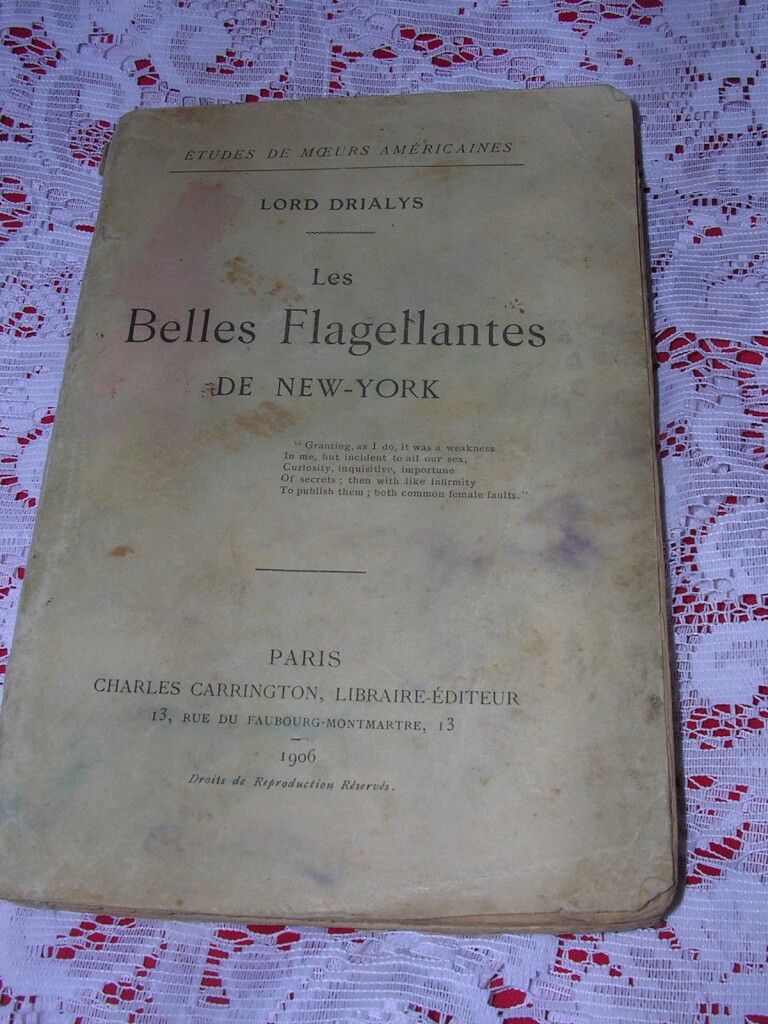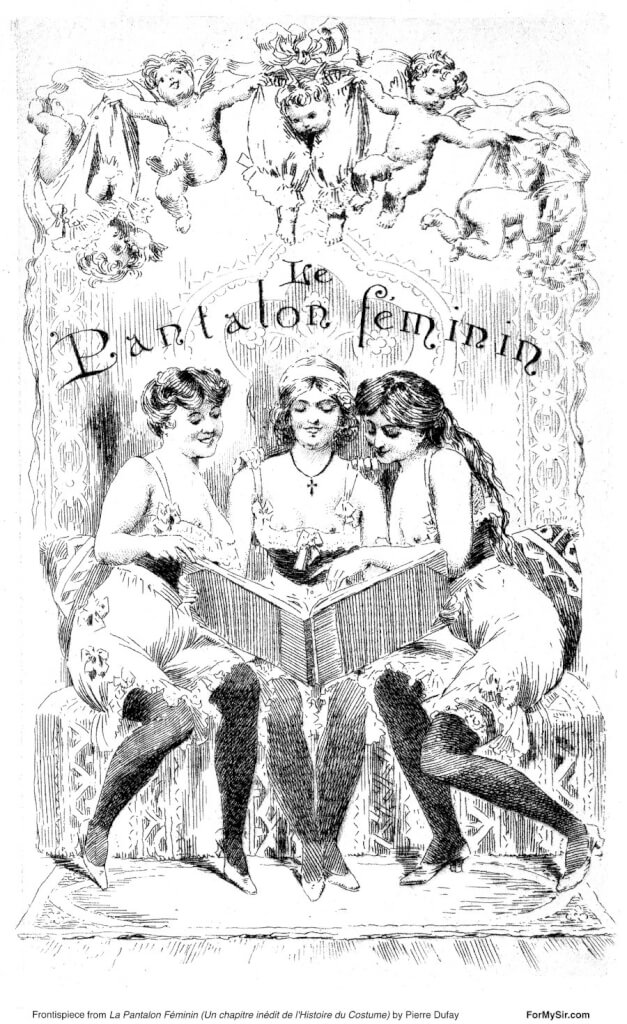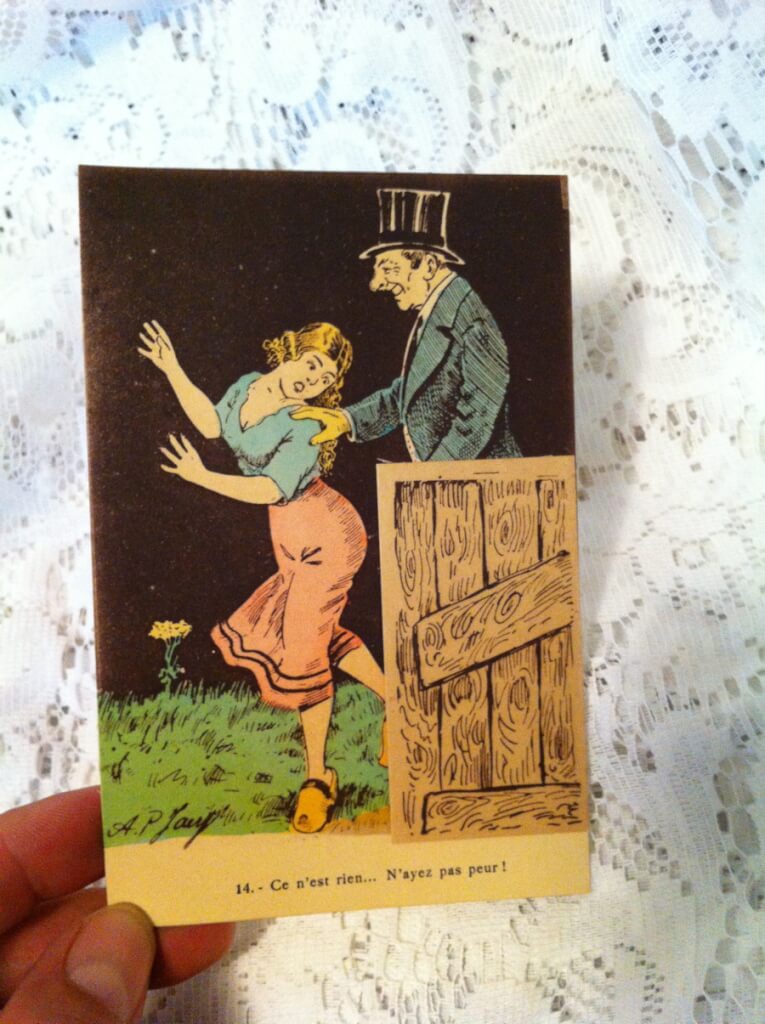-

 Nouvelles de Jean Boccace, Giovanni Boccaccio, trans. Mirabeau, illus. Marillier, engraved by Ponce [according to the Museum of Fine Arts - Boston, "Illustrated by Clément Pierre Marillier, Engraved by Wilbrode-Magloire-Nicolas Courbe, Engraved by Remi Henri Joseph Delvaux, Engraved by Nicholas Ponce, Etched by Devilliers, Author Giovanni Boccaccio, Publisher L. Duprat, Letellier et Cie, Printer A. Egron"] (Chez L. Duprat, Paris, 1802) 8" X 5.25", 4 vol. xx 304pp, 273pp, 243pp, 293pp, leather bound with gilt decorations on spine and around edges of boards, marbled end papers, armorial bookplate of the Earl of Normanton on all vols. gilt edges (mostly soiled). Owner's signature on front pages "A. Baillu 1819" Ribbons intact. Numerous beautifuly and detailed plates throughout. Good condition for age. Honoré Gabriel Riqueti, Comte de Mirabeau (1749-1791) was a French writer, popular orator and statesman (who communicated with Thomas Jefferson and Benjamin Franklin). He is remembered for his books Erotica biblion, Ma conversion, and his love letters to Sophie which written during his imprisonment at the donjon de Vincennes between 1777-1780 (while another prisoner, the Marquis de Sade was also incarcerated there. Yes, they met... No, they didn't like each other.) This book was also written in the Vincennes prison. According to Mirabeau's biography this was a "collection presented as a translation of Boccaccio, but which, as the author himself confesses in his introduction, is nothing more than simple sketches of some of the tales in the Decameron.... Mirabeau imitated some of the licentious tales which alone are known to the general reader, but took no notice of the other articles which abound in the Decameron, because they neither suited his views nor the public taste." A beautiful and rare book with exquisite engravings. This book is in the collection at the MFA-Boston and other museums.
Nouvelles de Jean Boccace, Giovanni Boccaccio, trans. Mirabeau, illus. Marillier, engraved by Ponce [according to the Museum of Fine Arts - Boston, "Illustrated by Clément Pierre Marillier, Engraved by Wilbrode-Magloire-Nicolas Courbe, Engraved by Remi Henri Joseph Delvaux, Engraved by Nicholas Ponce, Etched by Devilliers, Author Giovanni Boccaccio, Publisher L. Duprat, Letellier et Cie, Printer A. Egron"] (Chez L. Duprat, Paris, 1802) 8" X 5.25", 4 vol. xx 304pp, 273pp, 243pp, 293pp, leather bound with gilt decorations on spine and around edges of boards, marbled end papers, armorial bookplate of the Earl of Normanton on all vols. gilt edges (mostly soiled). Owner's signature on front pages "A. Baillu 1819" Ribbons intact. Numerous beautifuly and detailed plates throughout. Good condition for age. Honoré Gabriel Riqueti, Comte de Mirabeau (1749-1791) was a French writer, popular orator and statesman (who communicated with Thomas Jefferson and Benjamin Franklin). He is remembered for his books Erotica biblion, Ma conversion, and his love letters to Sophie which written during his imprisonment at the donjon de Vincennes between 1777-1780 (while another prisoner, the Marquis de Sade was also incarcerated there. Yes, they met... No, they didn't like each other.) This book was also written in the Vincennes prison. According to Mirabeau's biography this was a "collection presented as a translation of Boccaccio, but which, as the author himself confesses in his introduction, is nothing more than simple sketches of some of the tales in the Decameron.... Mirabeau imitated some of the licentious tales which alone are known to the general reader, but took no notice of the other articles which abound in the Decameron, because they neither suited his views nor the public taste." A beautiful and rare book with exquisite engravings. This book is in the collection at the MFA-Boston and other museums. -
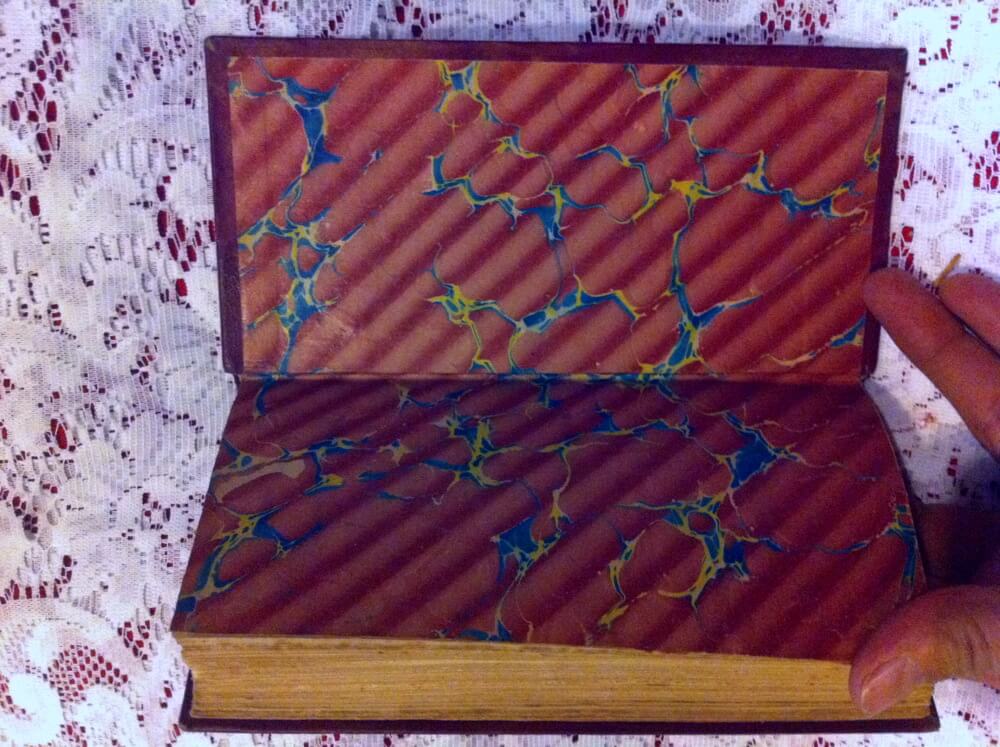
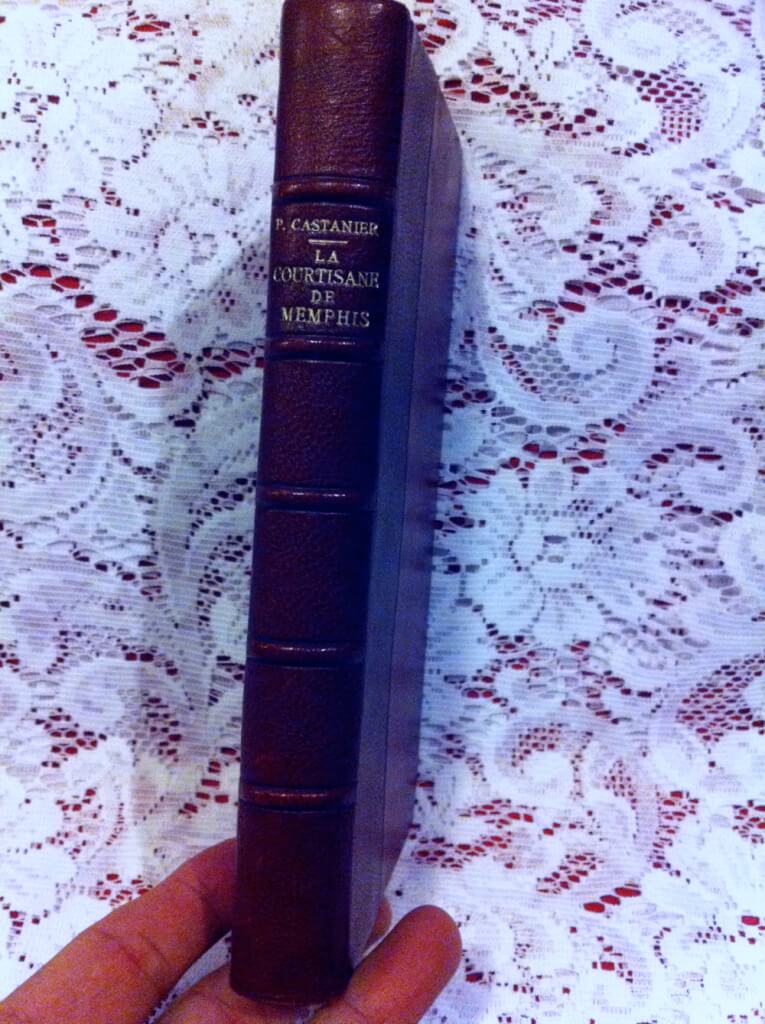 La Courtisane de Memphis, Prosper Castanier, illust. by A. Calbet (Librairie L. Borel, Paris, 1900 "Nymphée Collection") 7.75" X 4", 242pp.+, 1/2 red leather over silk-covered boards, marbled end-papers, gallery of 7 full-page illustrations in red, 5 pages of ads in back, fine condition for age, ribbon intact. In French, The Courtesan of Memphis. Prosper Castanier wrote of the decadence of ancient Rome. This is a beautiful example of a rare book. The French author, poet, novelist and historian Prosper Castanier (1865-19??) was born in Saint-Ambroix (Gard). He was the editor-in-chief of the "Progrès du midi". He had made a specialty of novels set in antiquity. (Particularly after the success of Aphrodite by Pierre Louès, published in 1896)
La Courtisane de Memphis, Prosper Castanier, illust. by A. Calbet (Librairie L. Borel, Paris, 1900 "Nymphée Collection") 7.75" X 4", 242pp.+, 1/2 red leather over silk-covered boards, marbled end-papers, gallery of 7 full-page illustrations in red, 5 pages of ads in back, fine condition for age, ribbon intact. In French, The Courtesan of Memphis. Prosper Castanier wrote of the decadence of ancient Rome. This is a beautiful example of a rare book. The French author, poet, novelist and historian Prosper Castanier (1865-19??) was born in Saint-Ambroix (Gard). He was the editor-in-chief of the "Progrès du midi". He had made a specialty of novels set in antiquity. (Particularly after the success of Aphrodite by Pierre Louès, published in 1896) -
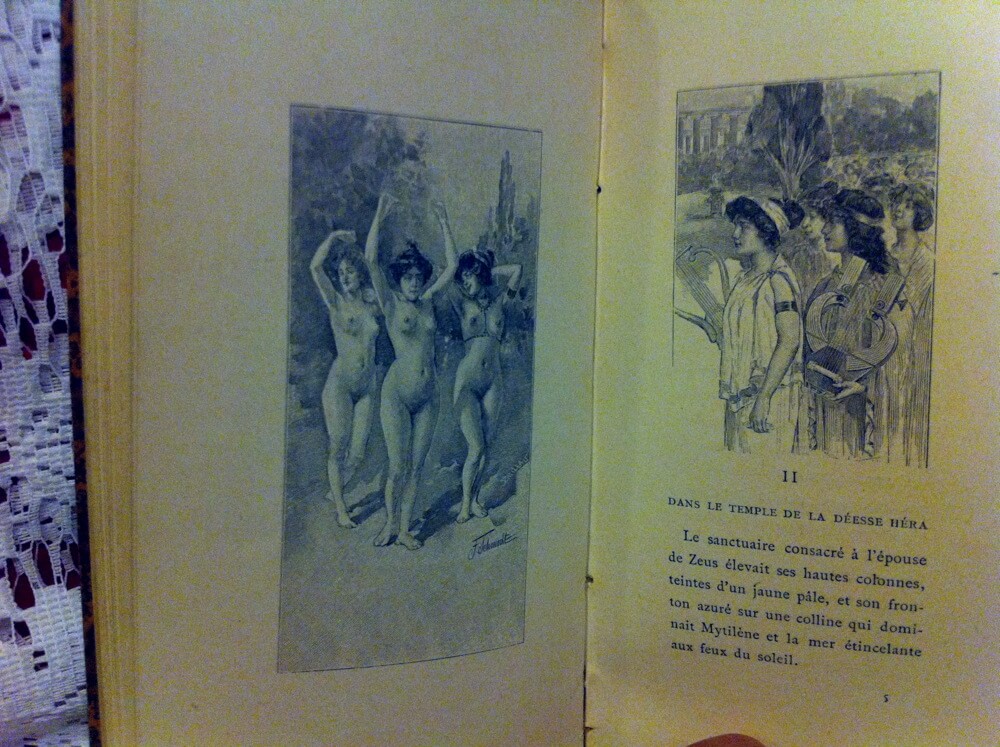
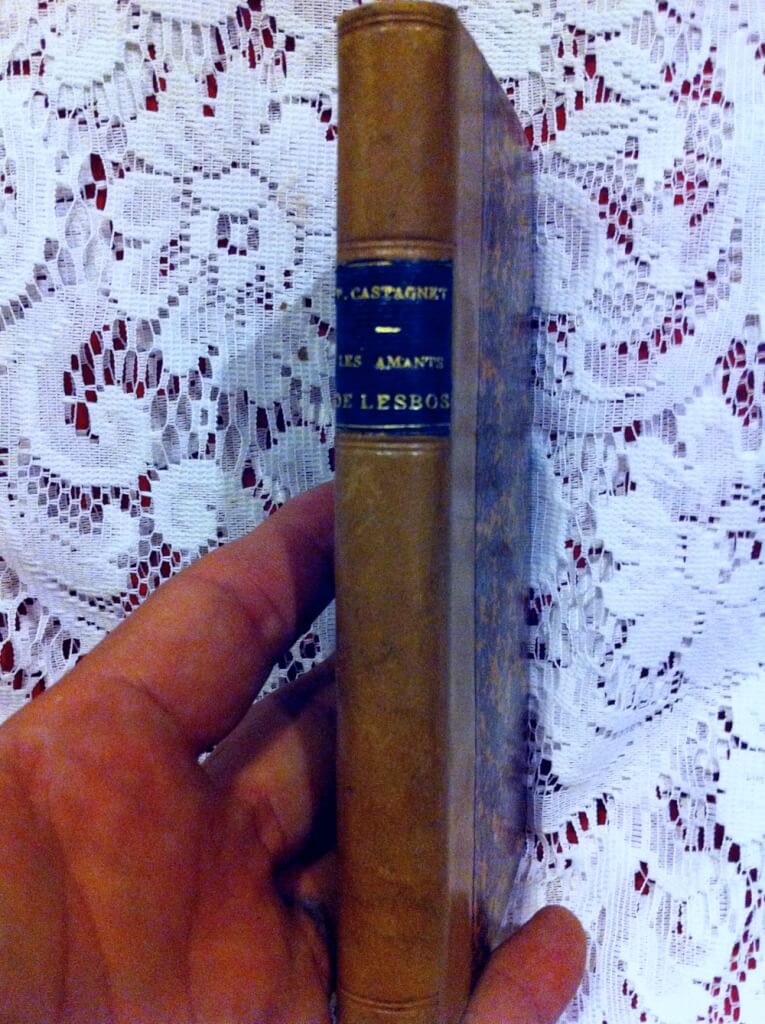 Les Amants de Lesbos, Prosper Castanier, illus. Franz Schmidt (Librairie L. Borel, Paris, 1900) 6" X 3.25", 116pp, Hardbound in 1/4 tan leather over marbled boards, marbled end-papers, glassine protective tissue for title page with gold emblem stamped on it. Very good condition. An imagination of the life and loves of the poet Sappho and her fight against the tyrant of Mytilene. The French author, poet, novelist and historian Prosper Castanier (1865-19??) was born in Saint-Ambroix (Gard). He was the editor-in-chief of the "Progrès du midi". He had made a specialty of novels set in antiquity. (Particularly after the success of Aphrodite by Pierre Louès, published in 1896)
Les Amants de Lesbos, Prosper Castanier, illus. Franz Schmidt (Librairie L. Borel, Paris, 1900) 6" X 3.25", 116pp, Hardbound in 1/4 tan leather over marbled boards, marbled end-papers, glassine protective tissue for title page with gold emblem stamped on it. Very good condition. An imagination of the life and loves of the poet Sappho and her fight against the tyrant of Mytilene. The French author, poet, novelist and historian Prosper Castanier (1865-19??) was born in Saint-Ambroix (Gard). He was the editor-in-chief of the "Progrès du midi". He had made a specialty of novels set in antiquity. (Particularly after the success of Aphrodite by Pierre Louès, published in 1896) -
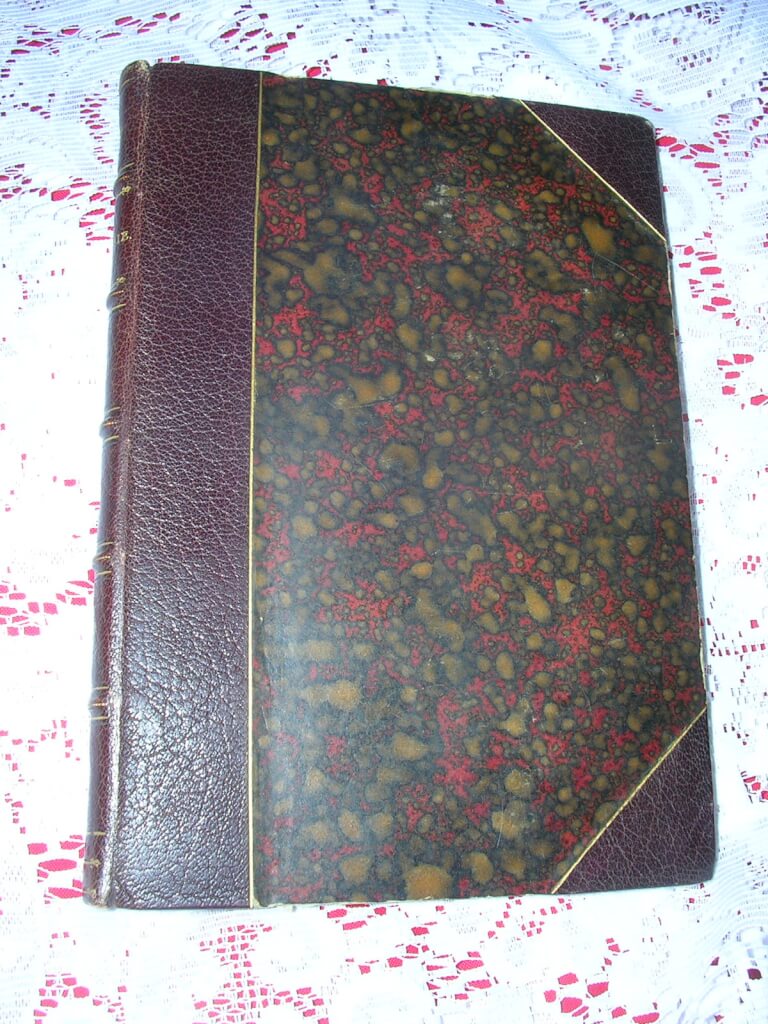
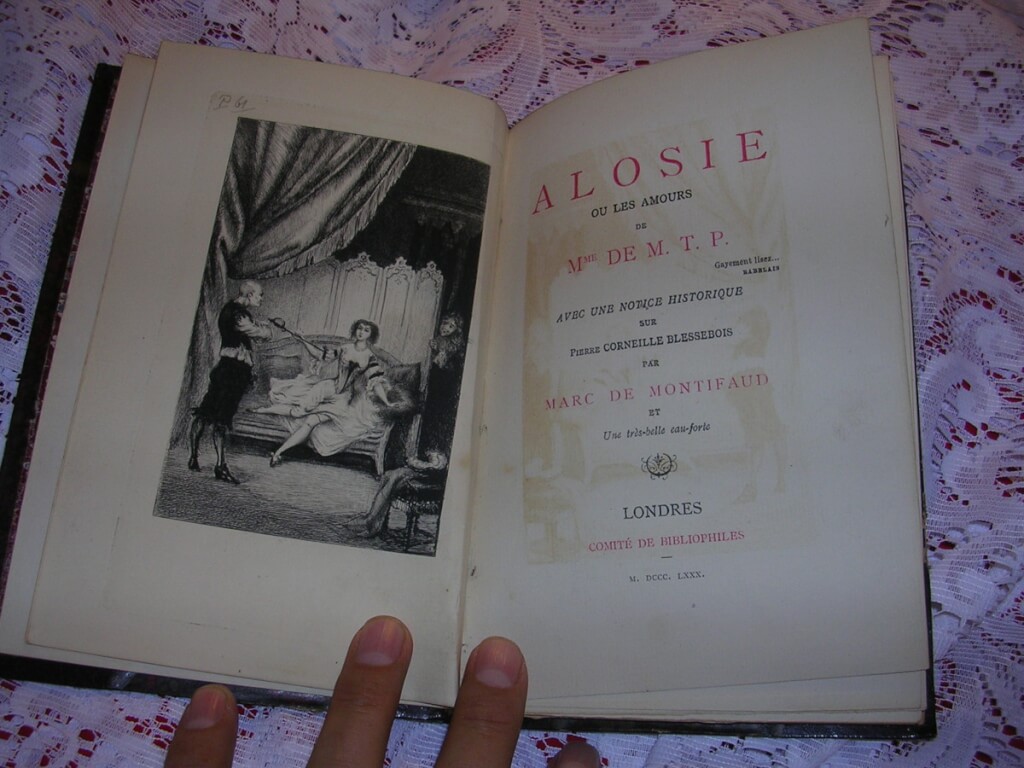 Alosie, ou Les Amours de Mme. de M. T. P. | Avec une notice historique sur Pierre Corneille Blessebois par Marc de Montifaud et Une très-belle eau-forte, Marc de Montifaud [pseud. Marie-Amélie Chartroule, Mme Quivogne de Montifaud] (Comité de Bibliophiles, London, 1880 [131/500 printed on Holland paper]) 7.5" x 5.25", 104pp, hardbound 1/2 leather, marbled boards and endpapers, gilt decorationson spine and leather corners, five raised bands on spine. Top edge gilt. Frontispiece engraving. #131 of 300 on Holland paper. Great condition for age. Initials "P.G." above frontispiece. Mme Quivogne de Montifaud (1845-50 to 1912/13) french writer and "free-thinker". She often dressed as her male pseudonym Marc de Montifaud. This book (published in London in 1880) is a reprint of part of the larger 17th century erotic work, "Amours des dames illustres de nostre siècle" (Loves of Illustrious Ladies of our Century) with an essay where Montifaud tries to unravel the authorship (usually the work is attributed to Pierre Corneille Blessebois). The author changes the original name to reflect that this is an autobiography of Madame de Montespan, the notorius mistress of Louis XIV. When originally published in Holland in 1878 (as "Lupanie, histoire amoureuse de ce temps") a court in Seine called it a moral outrage describing "licentious scenes on almost every page; told in a style revoltingly obscene". For publishing this book Montifaud was sentenced to 8 days in jail and fined 500 francs and ordered all copies of the book destroyed. The publisher was also fined 500 francs. This is a rare copy of a rare book in it's original "publishers leather".
Alosie, ou Les Amours de Mme. de M. T. P. | Avec une notice historique sur Pierre Corneille Blessebois par Marc de Montifaud et Une très-belle eau-forte, Marc de Montifaud [pseud. Marie-Amélie Chartroule, Mme Quivogne de Montifaud] (Comité de Bibliophiles, London, 1880 [131/500 printed on Holland paper]) 7.5" x 5.25", 104pp, hardbound 1/2 leather, marbled boards and endpapers, gilt decorationson spine and leather corners, five raised bands on spine. Top edge gilt. Frontispiece engraving. #131 of 300 on Holland paper. Great condition for age. Initials "P.G." above frontispiece. Mme Quivogne de Montifaud (1845-50 to 1912/13) french writer and "free-thinker". She often dressed as her male pseudonym Marc de Montifaud. This book (published in London in 1880) is a reprint of part of the larger 17th century erotic work, "Amours des dames illustres de nostre siècle" (Loves of Illustrious Ladies of our Century) with an essay where Montifaud tries to unravel the authorship (usually the work is attributed to Pierre Corneille Blessebois). The author changes the original name to reflect that this is an autobiography of Madame de Montespan, the notorius mistress of Louis XIV. When originally published in Holland in 1878 (as "Lupanie, histoire amoureuse de ce temps") a court in Seine called it a moral outrage describing "licentious scenes on almost every page; told in a style revoltingly obscene". For publishing this book Montifaud was sentenced to 8 days in jail and fined 500 francs and ordered all copies of the book destroyed. The publisher was also fined 500 francs. This is a rare copy of a rare book in it's original "publishers leather". -
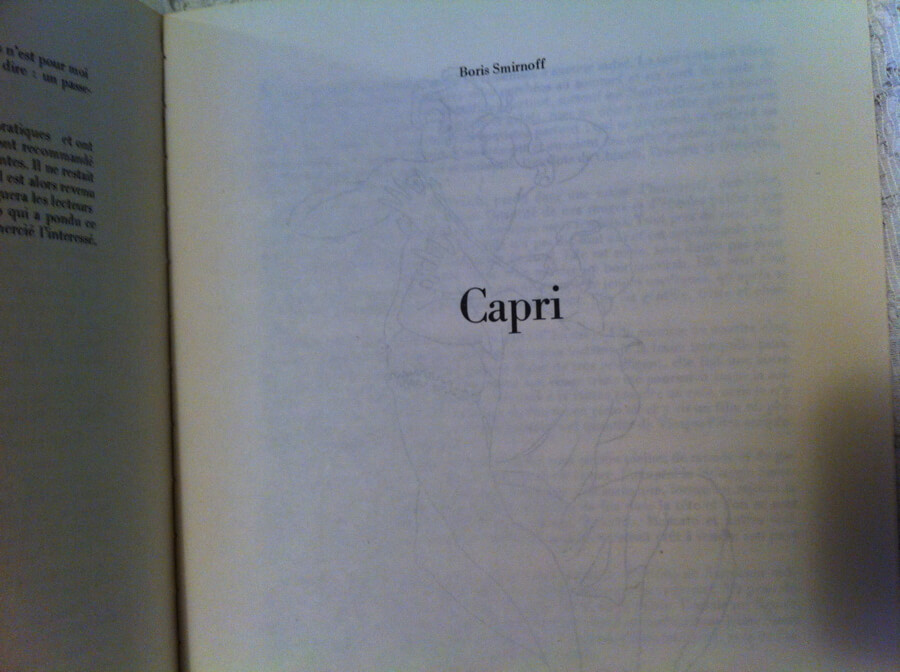
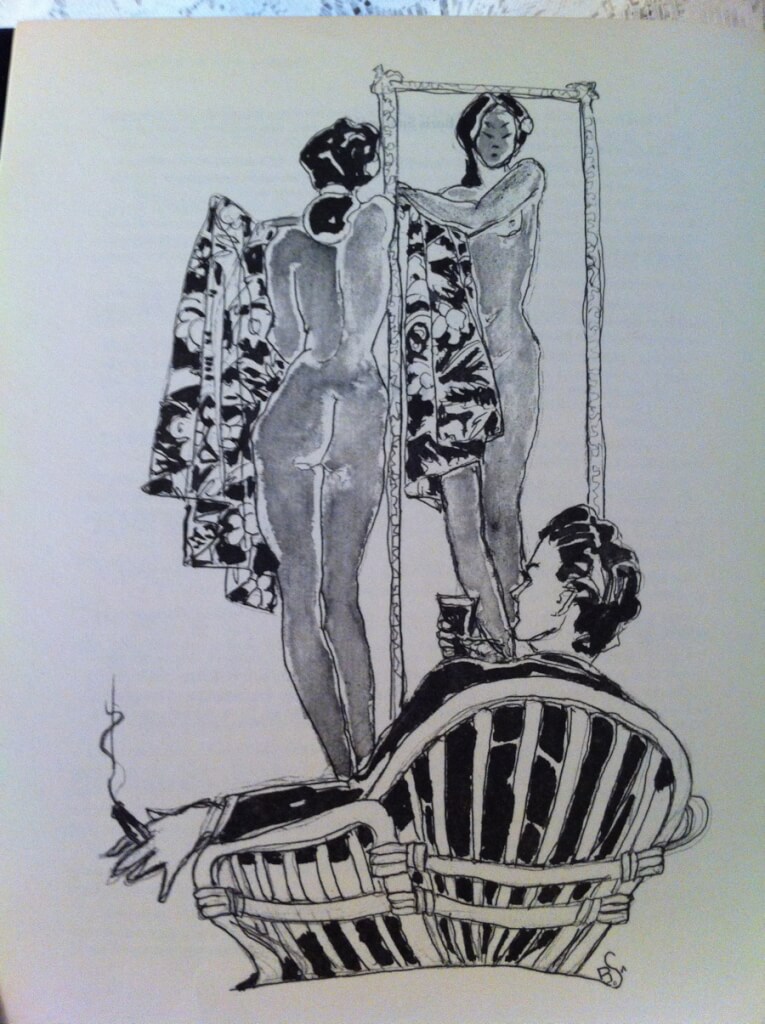 Nouvelles, Boris Smirnoff (Imprimerie Zimmermann, 1971) 9.75" x 7.75, soft cover, cover is black velvet, cover is loose, title page is unattached but the rest of the binding is holding. I do not find much mention of this book elsewhere. Very little is known to me about this book. I was able to find that Boris Smirnoff (1894 _ 1976), was born in Russia and settle in France following the "pogroms" of 1917. He was trained in the studio of Lucien Simon and attended the l'Ecole de Beaux-arts in Paris. He exhibited in Paris, London, Lisbon, New York, Stockholm, Bern, Geneva, Cairo, Palermo, Rome, Nice and Cannes and lived for most of his life in Cagnes-sur-Mer in the Alpes Maritimes. His works are held in museums throughout the world. These are erotic stories with illustrations by the author published in 1971.
Nouvelles, Boris Smirnoff (Imprimerie Zimmermann, 1971) 9.75" x 7.75, soft cover, cover is black velvet, cover is loose, title page is unattached but the rest of the binding is holding. I do not find much mention of this book elsewhere. Very little is known to me about this book. I was able to find that Boris Smirnoff (1894 _ 1976), was born in Russia and settle in France following the "pogroms" of 1917. He was trained in the studio of Lucien Simon and attended the l'Ecole de Beaux-arts in Paris. He exhibited in Paris, London, Lisbon, New York, Stockholm, Bern, Geneva, Cairo, Palermo, Rome, Nice and Cannes and lived for most of his life in Cagnes-sur-Mer in the Alpes Maritimes. His works are held in museums throughout the world. These are erotic stories with illustrations by the author published in 1971. -

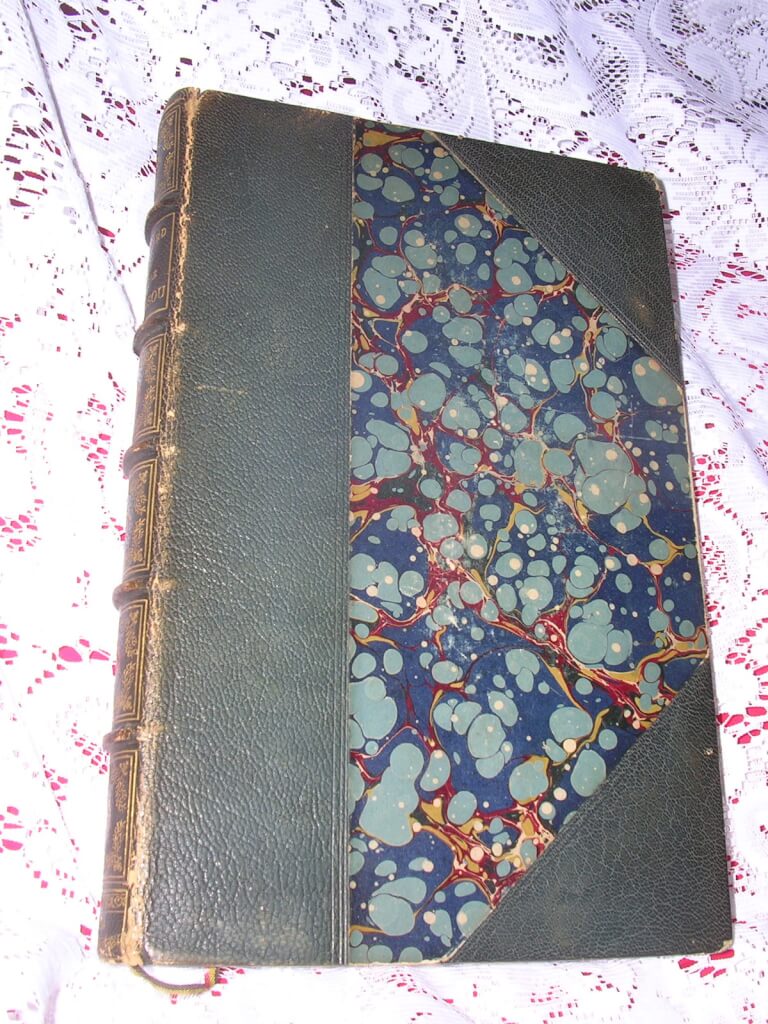 Mon Oncle Barbassou, Mario Uchard, illust. Paul Avril (J. Lemonnyer, Paris, 1884 [#394/1000, one of only 225 printed on Holland Paper]) 10" X 6.5", 311pp., hardbound in 3/4 dark blue morocco leather with gilt titles and decorations on spine with 5 raised bands, marbled endpapers, top edge gilt others deckled. First Illustrated Edition with many beautiful engravings by Paul Avril throughout. Some very slight wear to leather and boards, otherwise a very good+ copy overall clean, bright and structurally sound. #394/1000, one of only 275 in Holland Paper. Originally published in 4 parts in 1876, My Uncle Barbassou is a story of a man who inherits his uncle's estate which includes a newly purchased harem of 3 young girls. This novel is a prime example of the French "Orientalists" of the late 1800's. Scandalous for the age, but mild by today's standards, this book is in the original french. This is a beautifully bound copy of the First Illustrated Edition with plates by Paul Avril. Édouard-Henri Avril (1849-1928) used the pseudonym "Paul Avril" for his erotic work. He was a French painter and commercial artist. His career saw collaboration with influential people like Octave Uzanne, Henry Spencer Ashbee and Friedrich Karl Forberg. He is one of the most celebrated erotic artists of his age. Avril was a soldier before starting his career in art. He was awarded with the Legion of Honour for his actions in the Franco-Prussian War.
Mon Oncle Barbassou, Mario Uchard, illust. Paul Avril (J. Lemonnyer, Paris, 1884 [#394/1000, one of only 225 printed on Holland Paper]) 10" X 6.5", 311pp., hardbound in 3/4 dark blue morocco leather with gilt titles and decorations on spine with 5 raised bands, marbled endpapers, top edge gilt others deckled. First Illustrated Edition with many beautiful engravings by Paul Avril throughout. Some very slight wear to leather and boards, otherwise a very good+ copy overall clean, bright and structurally sound. #394/1000, one of only 275 in Holland Paper. Originally published in 4 parts in 1876, My Uncle Barbassou is a story of a man who inherits his uncle's estate which includes a newly purchased harem of 3 young girls. This novel is a prime example of the French "Orientalists" of the late 1800's. Scandalous for the age, but mild by today's standards, this book is in the original french. This is a beautifully bound copy of the First Illustrated Edition with plates by Paul Avril. Édouard-Henri Avril (1849-1928) used the pseudonym "Paul Avril" for his erotic work. He was a French painter and commercial artist. His career saw collaboration with influential people like Octave Uzanne, Henry Spencer Ashbee and Friedrich Karl Forberg. He is one of the most celebrated erotic artists of his age. Avril was a soldier before starting his career in art. He was awarded with the Legion of Honour for his actions in the Franco-Prussian War. -
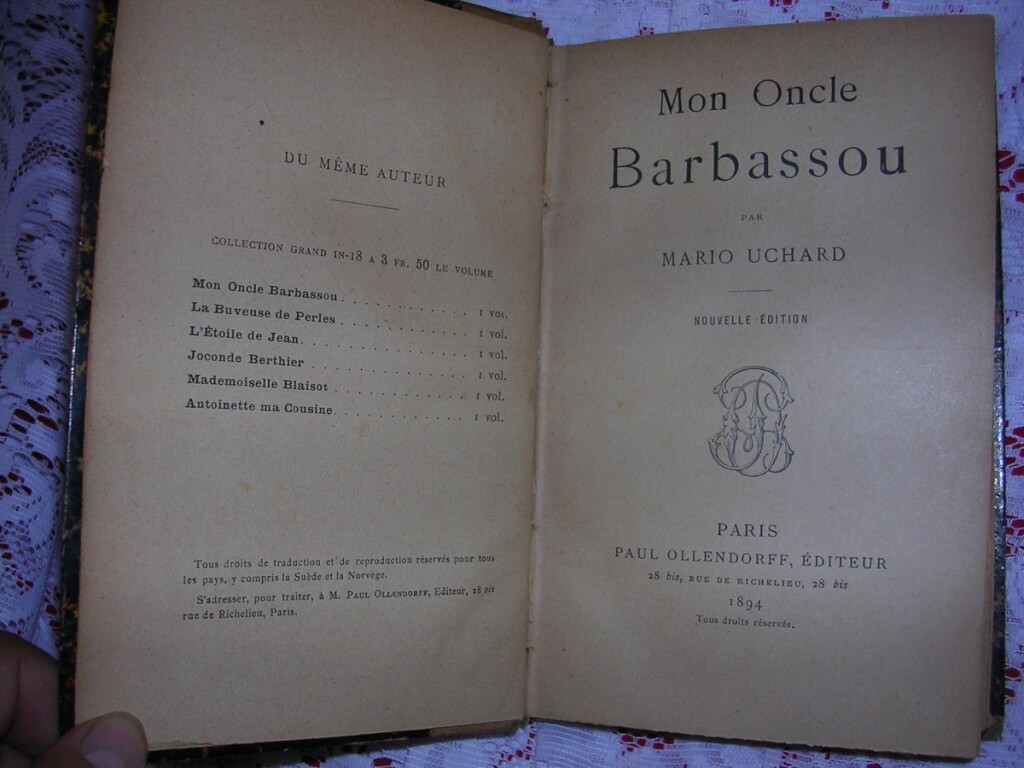
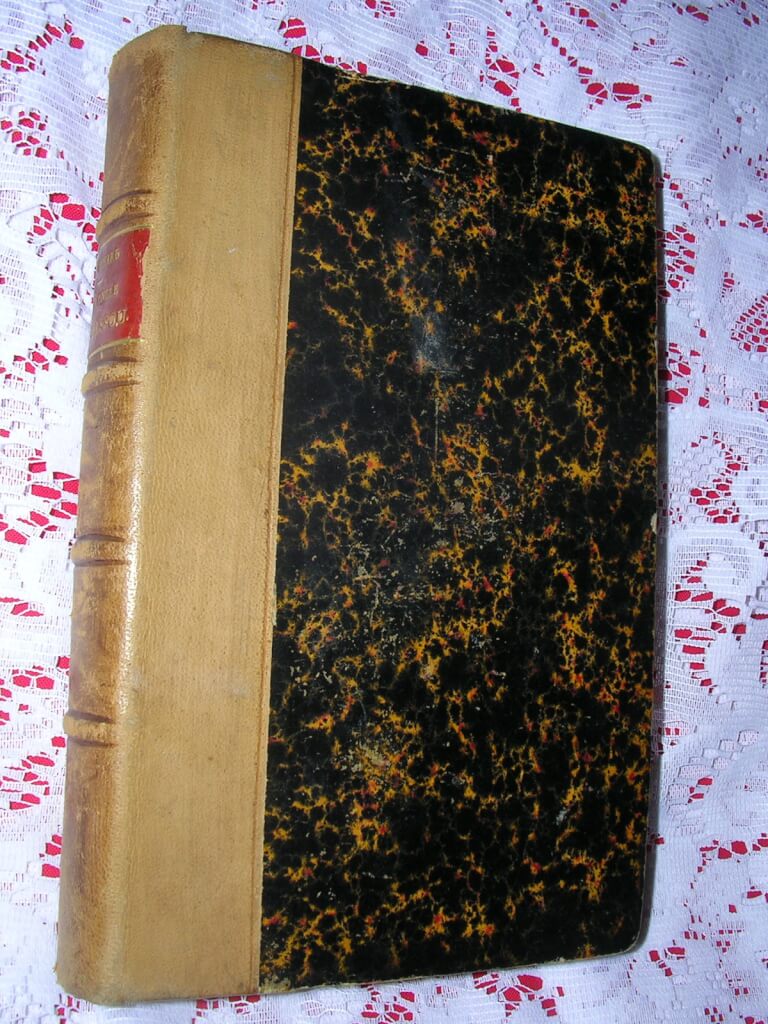 Mon Oncle Barbassou, Mario Uchard (Paul Ollendorff, ƒditeur, Paris, 1894, stated "Nouvelle Edition") 7.25" x 4.75", 405pp., hardbound, quarter leather, 4 raised bands on spine, title in gilt on red. Good condition for age, pages yellowing. Originally published in 4 parts in 1876, "Mon Oncle Barbassou" is a story of a man who inherits his uncle's estate which includes a newly purchased harem of 3 young girls. This novel is a prime example of the French "Orientalists" of the late 1800's. Scandalous for the age, but mild by today's standards, this book is in the original french.
Mon Oncle Barbassou, Mario Uchard (Paul Ollendorff, ƒditeur, Paris, 1894, stated "Nouvelle Edition") 7.25" x 4.75", 405pp., hardbound, quarter leather, 4 raised bands on spine, title in gilt on red. Good condition for age, pages yellowing. Originally published in 4 parts in 1876, "Mon Oncle Barbassou" is a story of a man who inherits his uncle's estate which includes a newly purchased harem of 3 young girls. This novel is a prime example of the French "Orientalists" of the late 1800's. Scandalous for the age, but mild by today's standards, this book is in the original french. -
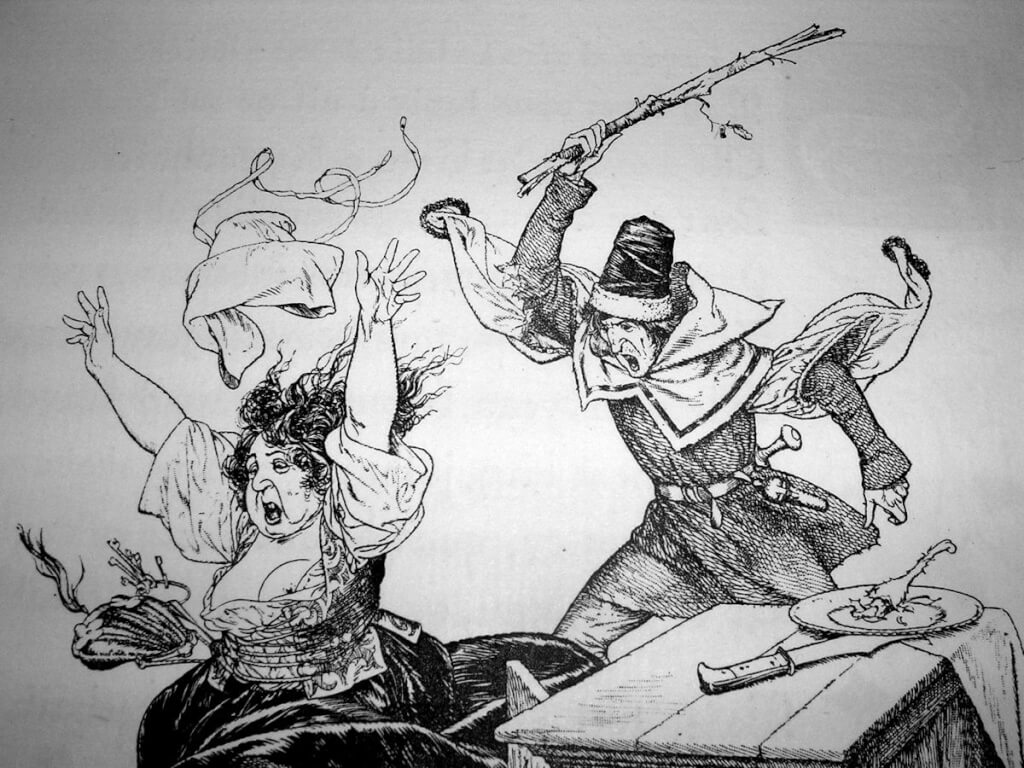
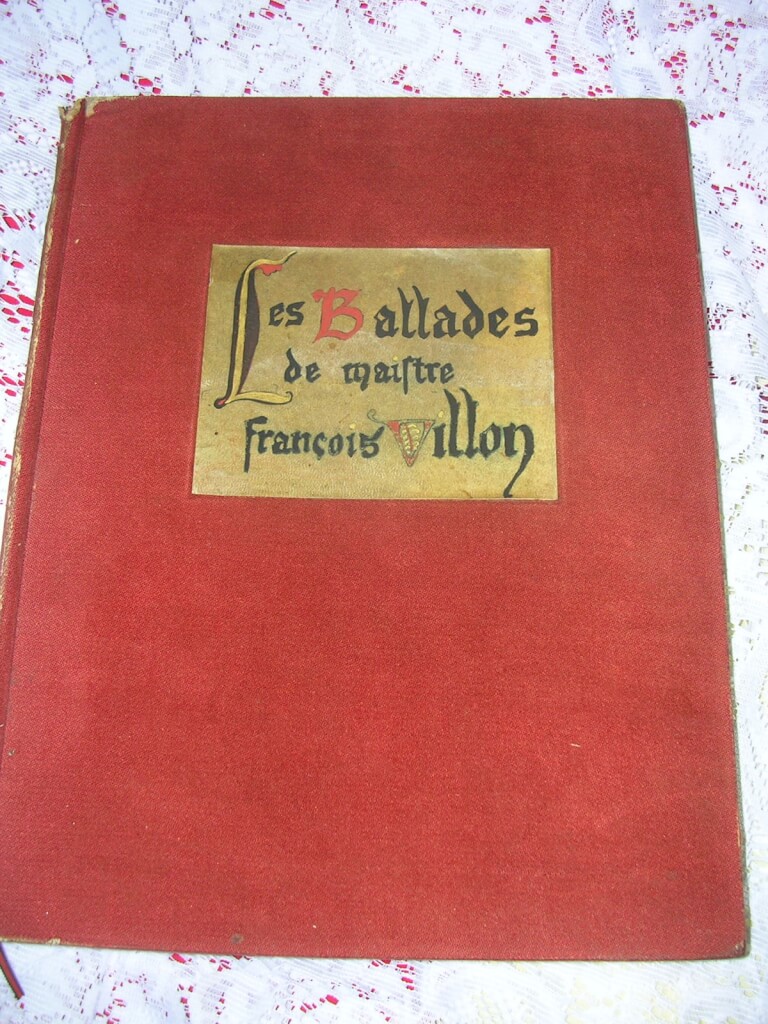 Les Ballades de Maistre Francois Villon, Francois Villon, illus. Chéri Hérouard, caligraphy ["escrites"] by Raymond de Rigné (chez Cres., Paris, 1919) 11.75" X 9.25", 169pp, rebound in red cloth boards with paper labels, decorated end papers. Original soft wraps intact. #450/550 signed by Hérouard. 31 full page drawings by Hérouard plus 31 small vignette type illustrations with a few "signed" by him. Beautifully printed on heavy deckle edged paper. good condition, wear to top and bottom of spine. ribbon intact. François Villon (c. 1431_1464) was a French poet. Most of what is known about Villon has been gathered from legal records and gleaned from his own writings. He was a thief, killer, barroom brawler, and vagabond. He is perhaps best known for his Testaments and his Ballades. He was the most famous realist poet of the Middle Ages. Chéri Hérouard (1881 - 1961) was a French illustrator who was most famously known for his forty-five-year work for French society magazine, La Vie Parisienne. Under the pseudonym of Herric, he also created erotic and sadomasochistic illustrations for various books including the Kama Sutra. This work was originally published with soft wraps. This copy has been beautifully rebound with it's original wraps intact.
Les Ballades de Maistre Francois Villon, Francois Villon, illus. Chéri Hérouard, caligraphy ["escrites"] by Raymond de Rigné (chez Cres., Paris, 1919) 11.75" X 9.25", 169pp, rebound in red cloth boards with paper labels, decorated end papers. Original soft wraps intact. #450/550 signed by Hérouard. 31 full page drawings by Hérouard plus 31 small vignette type illustrations with a few "signed" by him. Beautifully printed on heavy deckle edged paper. good condition, wear to top and bottom of spine. ribbon intact. François Villon (c. 1431_1464) was a French poet. Most of what is known about Villon has been gathered from legal records and gleaned from his own writings. He was a thief, killer, barroom brawler, and vagabond. He is perhaps best known for his Testaments and his Ballades. He was the most famous realist poet of the Middle Ages. Chéri Hérouard (1881 - 1961) was a French illustrator who was most famously known for his forty-five-year work for French society magazine, La Vie Parisienne. Under the pseudonym of Herric, he also created erotic and sadomasochistic illustrations for various books including the Kama Sutra. This work was originally published with soft wraps. This copy has been beautifully rebound with it's original wraps intact. -
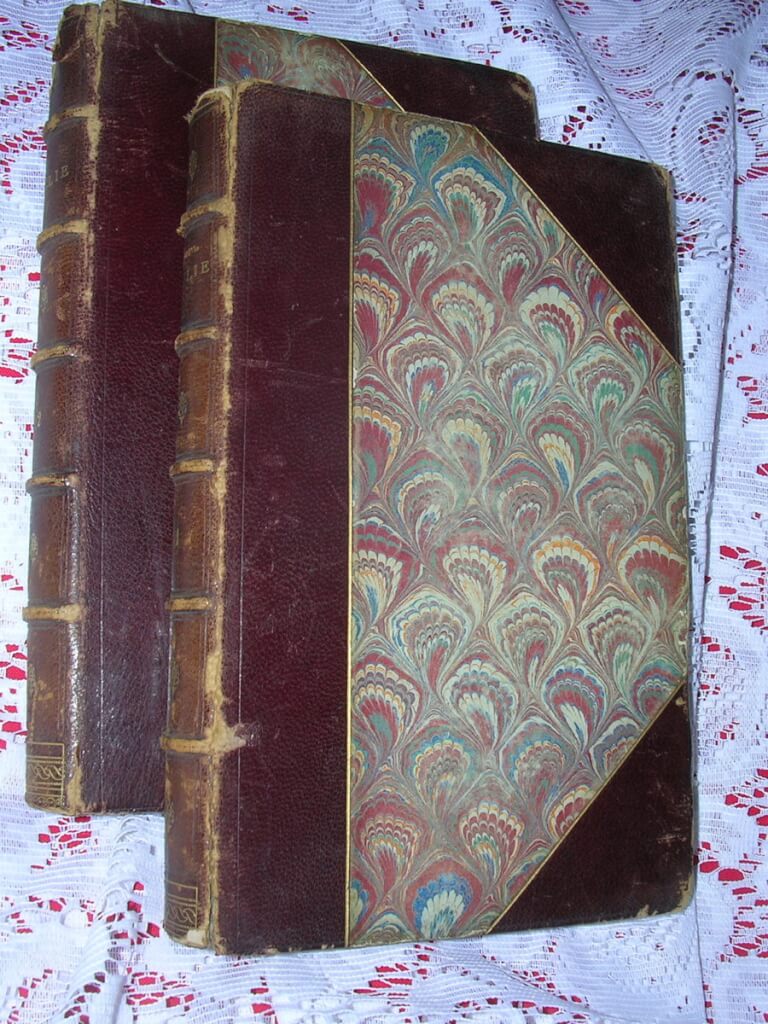
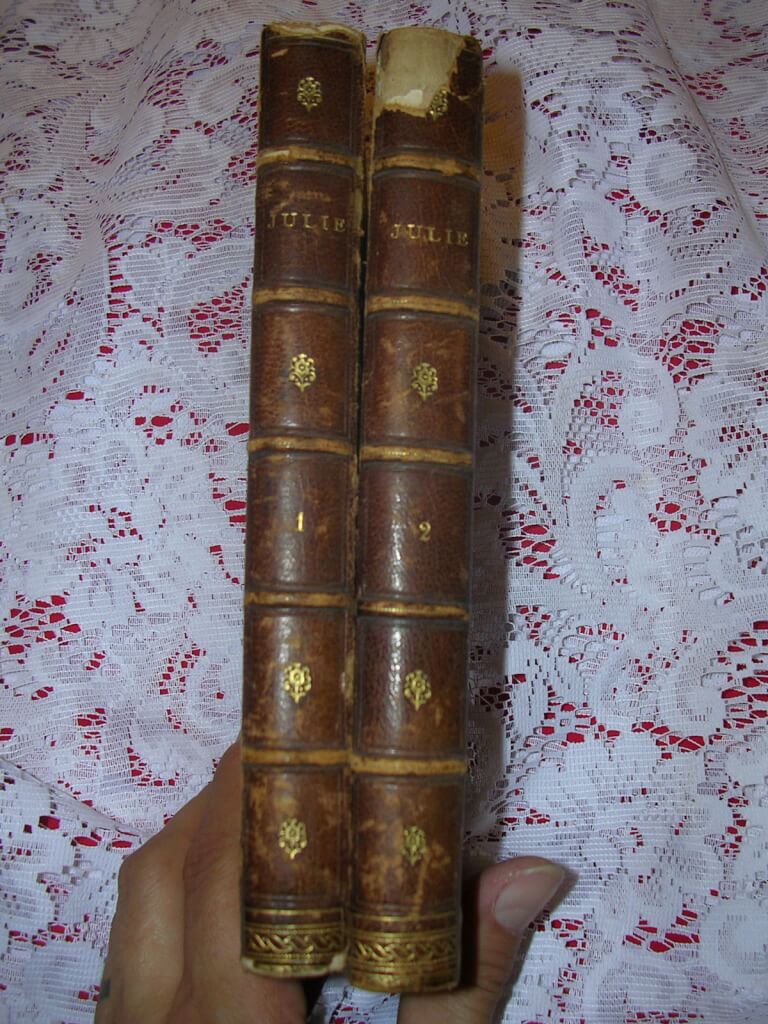 Julie, ou J'ai sauvé ma rose, Madame de C*** [Félicité Choiseul-Meuse] (Gay et Doucé, Bruxelles, 1882) 7.5" x 4.75", 2 vol. 169pp 188pp, hardbound half-leather over decorated paper boards and marbled endpapers. Gilt lettering and decorations on spine, 5 raised bands. 2 frontispiece engravings. Fair condition for age. Vol. 1 front boards loose and first few endpapers not attached, no missing pages, wear and tear to top of spine. Edges worn, corners bumped. Felicite de Choiseul-Meuse wrote approximately twenty-seven novels from 1797 to 1824. Writings are sometimes identified by pseudonyms and acronyms: LFDLC; Emilia P ***, Madame de C *** , etc.. Her 1807 novel "Julie, ou j'ai sauvé ma rose" [Julie, or I saved my rose] is widely considered the first erotic novel written by a woman. It is more appropriately translated as "how I kept my cherry" for it tells the tale of a young woman who lets her lovers fondle her all they want, but will not allow penetration until she finds the right man and marries him. The work was condemned as obscene and its destruction ordered by the Cour royale de Paris on August 5, 1828. Excerpt: "I tasted in his arms unspeakable pleasures. Deadened by pleasure, then revived by an even more delirious pleasure, I made the object of happiness almost as happy as I was myself; and yet, true to my system, I made sure that he did not harvest the rose."
Julie, ou J'ai sauvé ma rose, Madame de C*** [Félicité Choiseul-Meuse] (Gay et Doucé, Bruxelles, 1882) 7.5" x 4.75", 2 vol. 169pp 188pp, hardbound half-leather over decorated paper boards and marbled endpapers. Gilt lettering and decorations on spine, 5 raised bands. 2 frontispiece engravings. Fair condition for age. Vol. 1 front boards loose and first few endpapers not attached, no missing pages, wear and tear to top of spine. Edges worn, corners bumped. Felicite de Choiseul-Meuse wrote approximately twenty-seven novels from 1797 to 1824. Writings are sometimes identified by pseudonyms and acronyms: LFDLC; Emilia P ***, Madame de C *** , etc.. Her 1807 novel "Julie, ou j'ai sauvé ma rose" [Julie, or I saved my rose] is widely considered the first erotic novel written by a woman. It is more appropriately translated as "how I kept my cherry" for it tells the tale of a young woman who lets her lovers fondle her all they want, but will not allow penetration until she finds the right man and marries him. The work was condemned as obscene and its destruction ordered by the Cour royale de Paris on August 5, 1828. Excerpt: "I tasted in his arms unspeakable pleasures. Deadened by pleasure, then revived by an even more delirious pleasure, I made the object of happiness almost as happy as I was myself; and yet, true to my system, I made sure that he did not harvest the rose." -

 Mémoires de Fanny Hill, Femme de Plaisir, John Cleland (Bibliothèque Des Curieux, Paris, 1914) 9" X 5 5/8", 281pp, soft bound, deckle edges, many pages uncut/unread, "decorated with six compositions from the series of engravings by William Hogarth: La Destin_e d'une Courtisane", fair condition, good considering it's age, pages yellow and small rips near spine Written while the author was in debtor's prison in London and first published in 1749, Fanny Hill is considered the first original English prose pornography, and the first pornography to use the form of the novel. One of the most prosecuted and banned books in history, it has become a synonym for obscenity. This book appeared as a part of a series "Les Maitres de l'amour" (The Masters of Love). "With documents about life in London in the eighteenth century, including Life after the gallant Serails of London, Introduction and bibliography by Guillaume Apollinaire"
Mémoires de Fanny Hill, Femme de Plaisir, John Cleland (Bibliothèque Des Curieux, Paris, 1914) 9" X 5 5/8", 281pp, soft bound, deckle edges, many pages uncut/unread, "decorated with six compositions from the series of engravings by William Hogarth: La Destin_e d'une Courtisane", fair condition, good considering it's age, pages yellow and small rips near spine Written while the author was in debtor's prison in London and first published in 1749, Fanny Hill is considered the first original English prose pornography, and the first pornography to use the form of the novel. One of the most prosecuted and banned books in history, it has become a synonym for obscenity. This book appeared as a part of a series "Les Maitres de l'amour" (The Masters of Love). "With documents about life in London in the eighteenth century, including Life after the gallant Serails of London, Introduction and bibliography by Guillaume Apollinaire" -

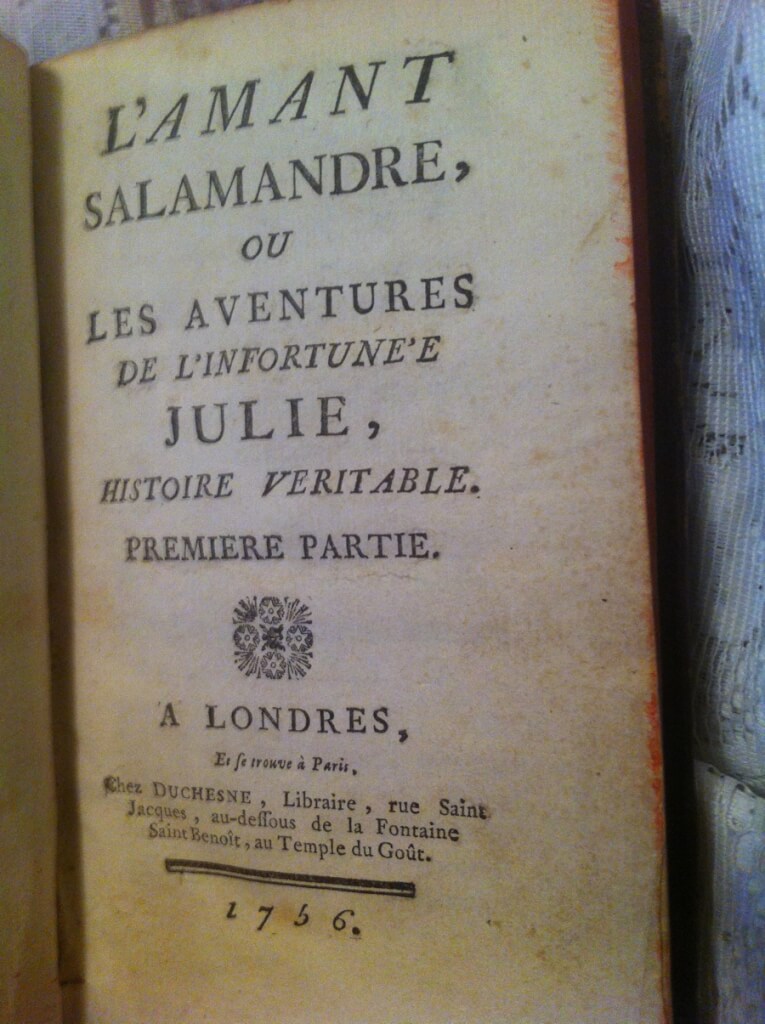 L'Amant Salamandre, ou Les Aventures de l'Infortunée Julie,Histoire Veritable, anonymous [Cointreau] , ("Londres, Et se trouve à Paris. Chez Duchesne" 1756, [first edition]) 4"x6.75", in two parts, 132pp, 135pp, Contemporary mottled calf, gilt decorations on spine, marbled boards, in good condition for age, some splitting at spine, but binding good. Julie is the bizarre tale of a young orphan tricked by her wicked governess into believing in magic. The governess delivers the girl to her son, who attempts to seduce her disguised as Salamandre, a magician. The young girl escapes to a convent, only to cross paths with the governess some time later, who once again tries to procure her for her son. 'Salamandre' is attacked by assassins and confesses his mother's crimes on his death bed. The novel was very popular in it's day. Although very popular in it's day, it's a rare find, especially the original 1756 version.
L'Amant Salamandre, ou Les Aventures de l'Infortunée Julie,Histoire Veritable, anonymous [Cointreau] , ("Londres, Et se trouve à Paris. Chez Duchesne" 1756, [first edition]) 4"x6.75", in two parts, 132pp, 135pp, Contemporary mottled calf, gilt decorations on spine, marbled boards, in good condition for age, some splitting at spine, but binding good. Julie is the bizarre tale of a young orphan tricked by her wicked governess into believing in magic. The governess delivers the girl to her son, who attempts to seduce her disguised as Salamandre, a magician. The young girl escapes to a convent, only to cross paths with the governess some time later, who once again tries to procure her for her son. 'Salamandre' is attacked by assassins and confesses his mother's crimes on his death bed. The novel was very popular in it's day. Although very popular in it's day, it's a rare find, especially the original 1756 version. -
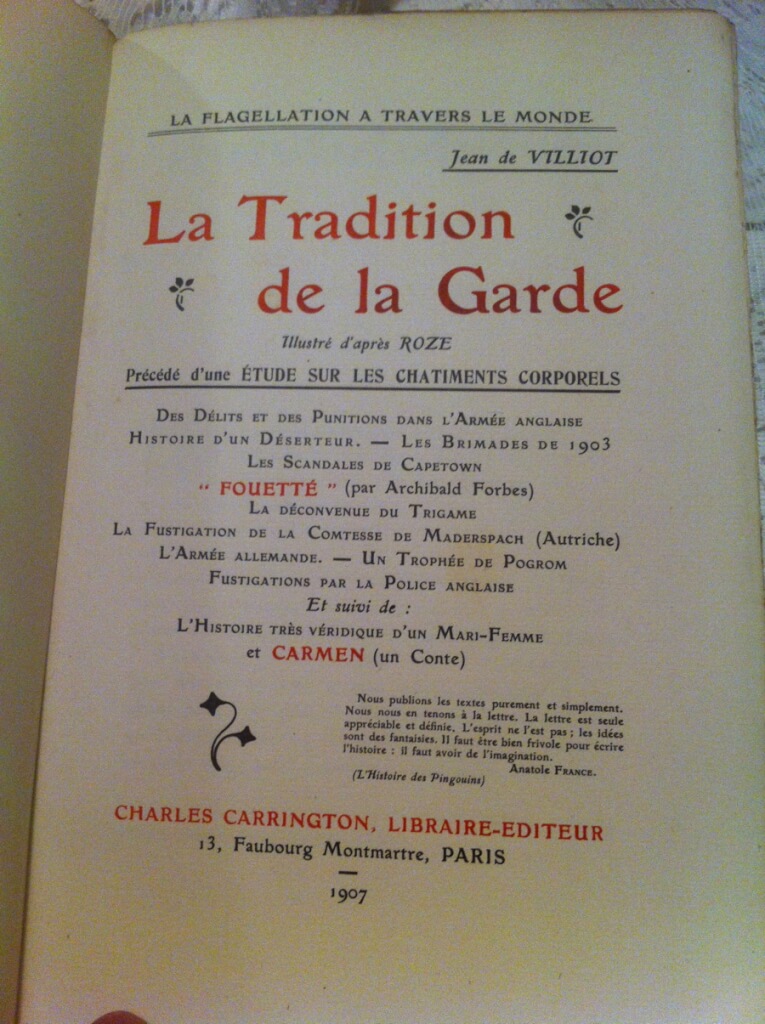
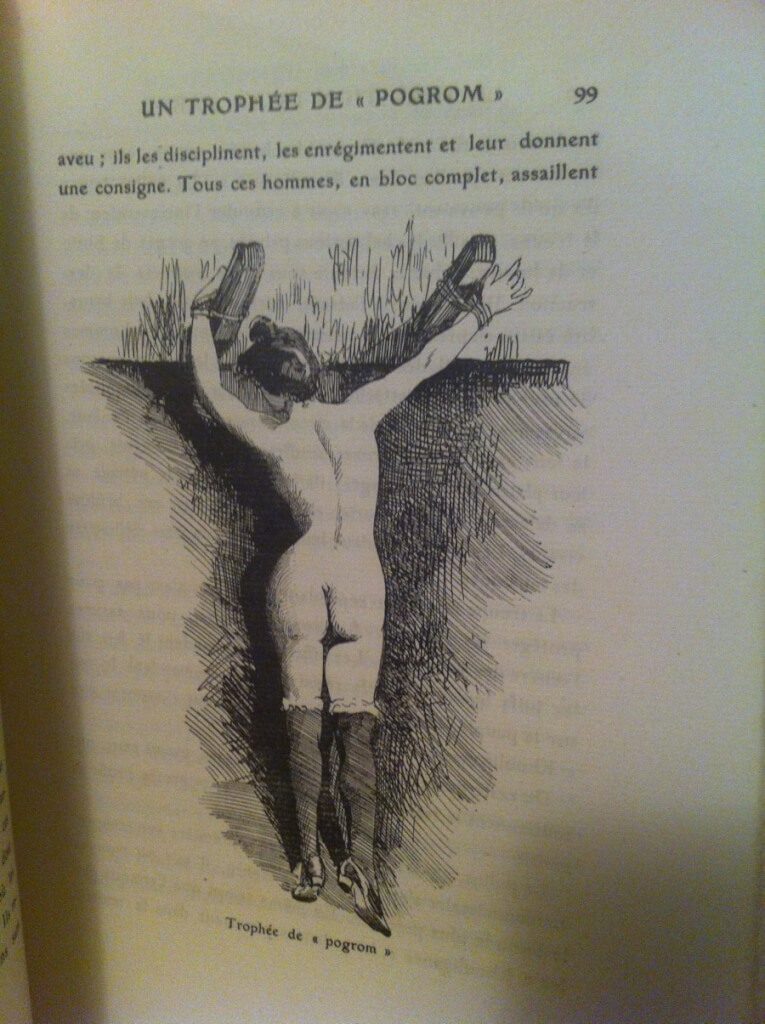 La Tradition de la Garde. Illustré d'après Roze. Précédé d'une étude sur les chatiments corporels. [Tradition of the Guard. Illustrated by Roze. Preceded by a study on corporal punishment.] by Jean de Villiot, [pseud. Georges Grassal de Choffat or Hugues Rebell], illus. Léon Roze (Charles Carrington, Paris, 1907, #244/700) 7.75" x 9.75", 209pp, very good condition for age, some light stains, soft covers and binding good, a rare, numerous illustrations
La Tradition de la Garde. Illustré d'après Roze. Précédé d'une étude sur les chatiments corporels. [Tradition of the Guard. Illustrated by Roze. Preceded by a study on corporal punishment.] by Jean de Villiot, [pseud. Georges Grassal de Choffat or Hugues Rebell], illus. Léon Roze (Charles Carrington, Paris, 1907, #244/700) 7.75" x 9.75", 209pp, very good condition for age, some light stains, soft covers and binding good, a rare, numerous illustrations -
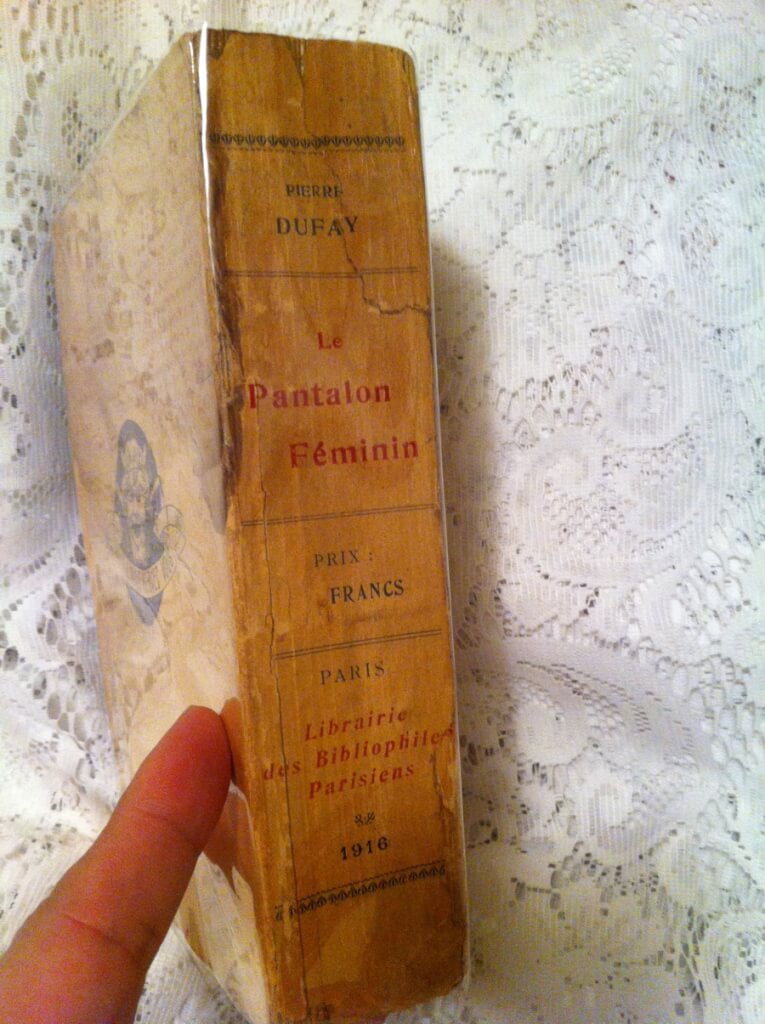
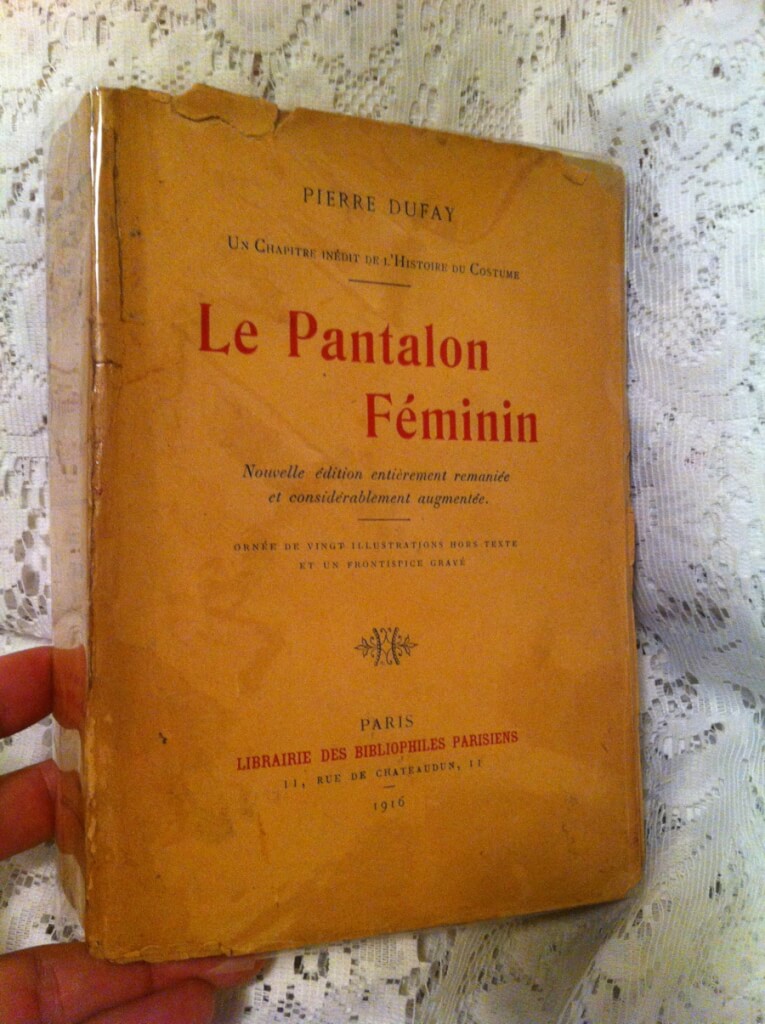 Le Pantalon Féminin (Un chapitre inédit de l'Histoire du Costume) by Pierre Dufay, preface by d'Armand Silvestre (Charles Carrington, Librairie Des Bibliophiles Parisiens, 1916, Paris) 7.75" X 5.75", xv 584pp., original soft wraps protected by a clear archival dust cover. Deckled edges. Some pages remain uncut. Index, table of contents, errata, and 5 pages of ads in the back. Good condition for age, some tears to the edges of cover, stain on the back. A rare find with it's illustrations intact.
Le Pantalon Féminin (Un chapitre inédit de l'Histoire du Costume) by Pierre Dufay, preface by d'Armand Silvestre (Charles Carrington, Librairie Des Bibliophiles Parisiens, 1916, Paris) 7.75" X 5.75", xv 584pp., original soft wraps protected by a clear archival dust cover. Deckled edges. Some pages remain uncut. Index, table of contents, errata, and 5 pages of ads in the back. Good condition for age, some tears to the edges of cover, stain on the back. A rare find with it's illustrations intact. -

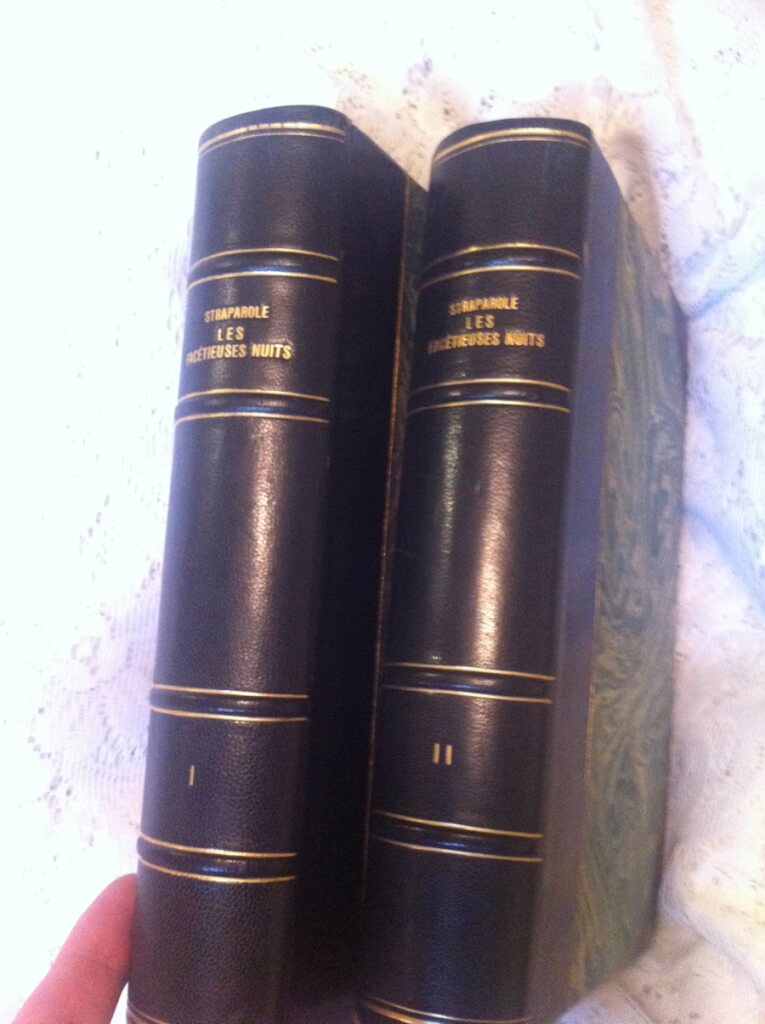 Les Facetieuses Nuits de Straparole, Giovanni Francesco Straparola, trans. Jean Louveau, illus. L_on Lebègue. Preface by Jules de Marthold (Charles Carrington, Paris, 1907 #213/800) 9.5" x 6.25", 2 vol. lxxxvii+312pp. vi+371pp. 1/2 leather over marbled boards, 4 raised bands on spine gilt lettering and decorations, marbled endpapers, gilted top-edge, others deckled, many color illustrations protected by tissues with descrptions printed on them, text decorations throughout, near fine condition, book binder tag for "Hans Uttinger, Buchbinderei, Einrahmungsgeschäft, Luzern" The Facetious Nights of Straparola (1550-1555; Italian: Le piacevoli notti), also known as The Nights of Straparola, is a two-volume collection of 75 stories by Italian author and fairy-tale collector Giovanni Francesco Straparola(c.1480-c.1557). Modeled after Bocaccio's Decameron, it has participants of a 13-night party in the island of Murano, near Venice, tell each other stories that vary from bawdy to fantastic. It contains the first known written versions of many fairy tales. It would influence later fairy-tale authors like Charles Perrault and Jacob and Wilhelm Grimm. This book is a very rare and famous (and famously illustrated) edition. A beautiful copy of a beautifully made book.
Les Facetieuses Nuits de Straparole, Giovanni Francesco Straparola, trans. Jean Louveau, illus. L_on Lebègue. Preface by Jules de Marthold (Charles Carrington, Paris, 1907 #213/800) 9.5" x 6.25", 2 vol. lxxxvii+312pp. vi+371pp. 1/2 leather over marbled boards, 4 raised bands on spine gilt lettering and decorations, marbled endpapers, gilted top-edge, others deckled, many color illustrations protected by tissues with descrptions printed on them, text decorations throughout, near fine condition, book binder tag for "Hans Uttinger, Buchbinderei, Einrahmungsgeschäft, Luzern" The Facetious Nights of Straparola (1550-1555; Italian: Le piacevoli notti), also known as The Nights of Straparola, is a two-volume collection of 75 stories by Italian author and fairy-tale collector Giovanni Francesco Straparola(c.1480-c.1557). Modeled after Bocaccio's Decameron, it has participants of a 13-night party in the island of Murano, near Venice, tell each other stories that vary from bawdy to fantastic. It contains the first known written versions of many fairy tales. It would influence later fairy-tale authors like Charles Perrault and Jacob and Wilhelm Grimm. This book is a very rare and famous (and famously illustrated) edition. A beautiful copy of a beautifully made book. -
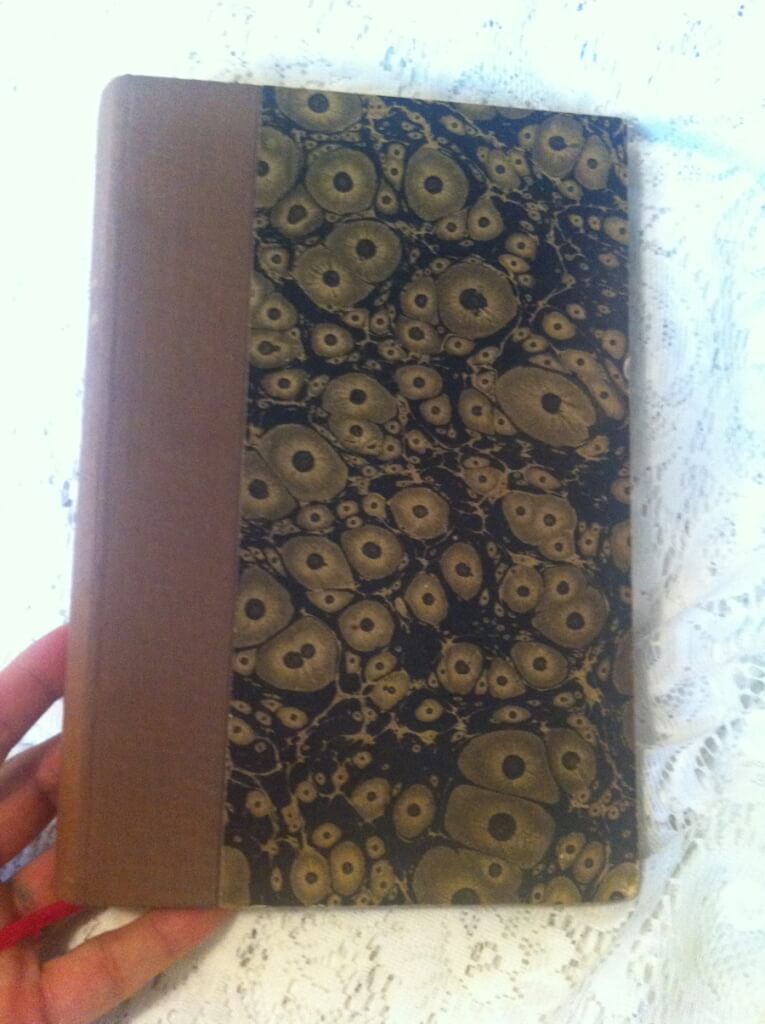
 Aphrodite, mœurs antiques, by Pierre Louÿs, illus. Eduard Zier (Librairie Illustree, J. Tallandier, Éditeur, nd [c. 1900], Paris, printed by Charles Hérissey, engravings executed by Ruckert et Cie, on Champon, Bichelberger et Cie ) 6.75" x 10", 374pp, hardbound in half buckram over marbled boards, very good condition for age, some bumping to boards and foxing throughout pages, red ribbon intact Pierre Louys (1870 - 1925) was a French poet and writer, most renowned for lesbian and classical themes in some of his writings. He is known as a writer who "expressed pagan sensuality with stylistic perfection." "Aphrodite: mæurs antiques" (Ancient Manners) is a "libertine" story set in ancient Alexandria. Highlights include the loves of Chrysis, an orgy banquet ending in the crucifixion of a slave, the love of two young musician girls and the festivals of Aphrodite.
Aphrodite, mœurs antiques, by Pierre Louÿs, illus. Eduard Zier (Librairie Illustree, J. Tallandier, Éditeur, nd [c. 1900], Paris, printed by Charles Hérissey, engravings executed by Ruckert et Cie, on Champon, Bichelberger et Cie ) 6.75" x 10", 374pp, hardbound in half buckram over marbled boards, very good condition for age, some bumping to boards and foxing throughout pages, red ribbon intact Pierre Louys (1870 - 1925) was a French poet and writer, most renowned for lesbian and classical themes in some of his writings. He is known as a writer who "expressed pagan sensuality with stylistic perfection." "Aphrodite: mæurs antiques" (Ancient Manners) is a "libertine" story set in ancient Alexandria. Highlights include the loves of Chrysis, an orgy banquet ending in the crucifixion of a slave, the love of two young musician girls and the festivals of Aphrodite. -

 Les métamorphoses ou l'asne d'or de Luce Apulée philosophe platonique, Lucius Apuleius Madaurensis (124-170 AD), trans. Jules De Marthold, illust. [21 etchings] Martin van Maele (Charles Carrington, Librairie-Éditeur, 1905, Paris, #88/750) 9.25" X 6.25", xlviii+328pp., original soft wraps protected by glassine wraps, Chapter pieces in orange and black, tail pieces in black, large, decorative first letter of each chapter, frontispiece + 21 full-page b/w engravings with tissue guards and numerous in-text illustrations by Martin van Maele, very good condition for age. The Metamorphoses of Apuleius, which St. Augustine referred to as "The Golden Ass", is the only Ancient Roman novel in Latin to survive in its entirety. The plot Lucius and his curiosity and insatiable desire to see and practice magic. While trying to perform a spell to transform into a bird, he is accidentally transformed into an ass. This leads to a long journey, literal and metaphorical, filled with in-set tales. He finally finds salvation through the intervention of the goddess Isis, whose cult he joins. The date of the original work is uncertain. Scholars are not sure if he wrote it in his youth or at the end of his life. He adapted the story from a Greek story written by Lucius of Patrae, however his original Greek text has long been lost. Maurice François Alfred Martin van Miële (1863-5 - 1926), better known by his pseudonym Martin van Maële, was a French illustrator of early 20th century literature. Though he gained notoriety with his illustration for H. G. Wells in Les Premiers Hommes dans la Lune, and he worked as an illustrator for the Félix Juven's French translations of the Sherlock Holmes series, he is now most widely renowned and mostly remembered for his erotic illustrations. This is a beautiful and rare book in it's original paper wraps.
Les métamorphoses ou l'asne d'or de Luce Apulée philosophe platonique, Lucius Apuleius Madaurensis (124-170 AD), trans. Jules De Marthold, illust. [21 etchings] Martin van Maele (Charles Carrington, Librairie-Éditeur, 1905, Paris, #88/750) 9.25" X 6.25", xlviii+328pp., original soft wraps protected by glassine wraps, Chapter pieces in orange and black, tail pieces in black, large, decorative first letter of each chapter, frontispiece + 21 full-page b/w engravings with tissue guards and numerous in-text illustrations by Martin van Maele, very good condition for age. The Metamorphoses of Apuleius, which St. Augustine referred to as "The Golden Ass", is the only Ancient Roman novel in Latin to survive in its entirety. The plot Lucius and his curiosity and insatiable desire to see and practice magic. While trying to perform a spell to transform into a bird, he is accidentally transformed into an ass. This leads to a long journey, literal and metaphorical, filled with in-set tales. He finally finds salvation through the intervention of the goddess Isis, whose cult he joins. The date of the original work is uncertain. Scholars are not sure if he wrote it in his youth or at the end of his life. He adapted the story from a Greek story written by Lucius of Patrae, however his original Greek text has long been lost. Maurice François Alfred Martin van Miële (1863-5 - 1926), better known by his pseudonym Martin van Maële, was a French illustrator of early 20th century literature. Though he gained notoriety with his illustration for H. G. Wells in Les Premiers Hommes dans la Lune, and he worked as an illustrator for the Félix Juven's French translations of the Sherlock Holmes series, he is now most widely renowned and mostly remembered for his erotic illustrations. This is a beautiful and rare book in it's original paper wraps. -
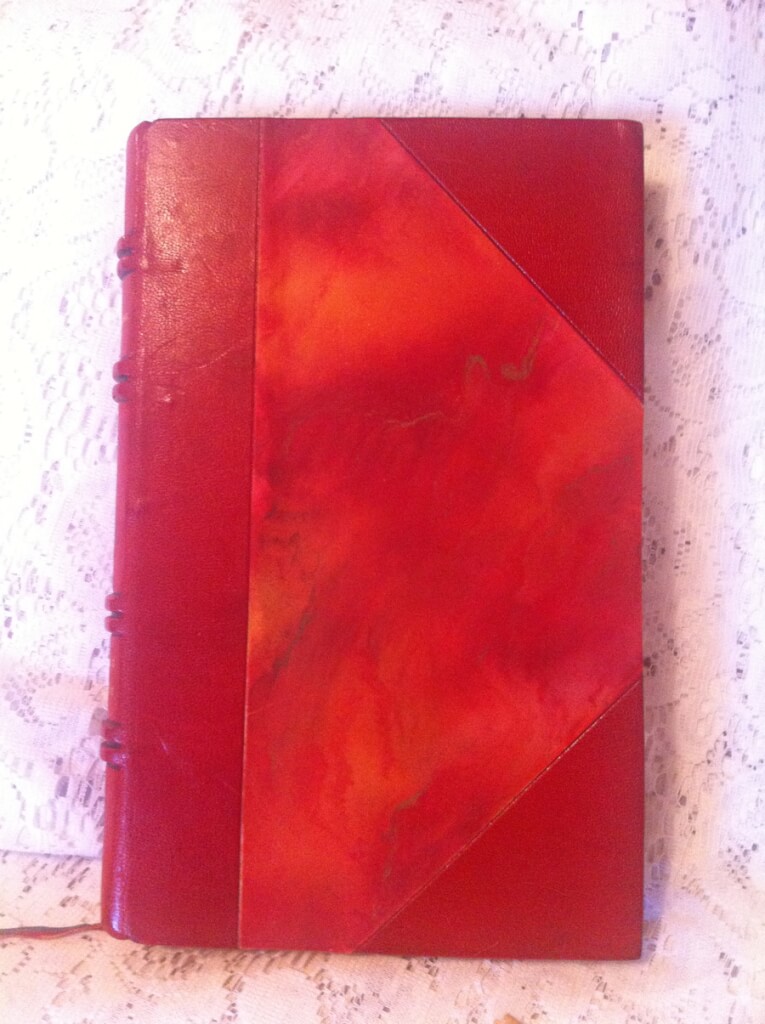
 Manuel D'Érotologie Classique (de figuris Veneris) by Fred. Chas. Forberg, trans. Alcide Bonneau (Imprimé pour René Bonnel, Paris, 1933, #123/500) 6" x 9.25", 223pp, three quarter red leather, gilt titles on spine, 4 raised double bands, near fine condition, ribbon intact, hand-laid Arches paper (identifying watermarks), original paper covers bound in. Rene Bonnel, the publisher of this edition, was one of the foremost publishers of finely printed illegal erotica in the 1930's. This work was openly published and is no exception to the quality of his books. De figuris Veneris (On the figures of Venus) was an anthology of ancient Greek and ancient Roman writings on erotic topics, discussed objectively and classified and grouped by subject matter. (I. Of Copulation, II. Of Pederastia, III. Of Irrumation, IV. Of Masturbation, V. Of Cunnilingues, VI. Of Tribads, VII. Of Intercourse with Animals, VIII. Of Spintrian Postures) It was first published by the German classicist Friedrich Karl Forberg in 1824 in Latin and Greek as “Antonii Panormitae Hermaphroditus”, an erotic poem sequence in renaissance Latin. Forberg later reprinted it as “Manuel D’Érotologie Classique (de figuris Veneris)”. It was translated into English (published by Charles Carrington in 1899 and again by Charles Hirsch in 1907), French and German (one French edition was illustrated by Édouard-Henri Avril [Paul Avril]). It concludes with a list of 95 sexual positions. In 1899 Forberg's work was translated into English and published by Charles Carrington as De figuris Veneris, Manual of classical erotology, and again in 1907 by Charles Hirsch, and into French, German and Spanish. The French edition by Alcide Bonneau was titled Manuel d’érotologie classique. One French edition of 1906 was illustrated by Édouard-Henri Avril, which concludes with a list of 95 sexual positions. Most of the editions were restricted to high society or censored; one of the copies edited in France was immediately deposited on the secret shelves of the Bibliothèque nationale de France.
Manuel D'Érotologie Classique (de figuris Veneris) by Fred. Chas. Forberg, trans. Alcide Bonneau (Imprimé pour René Bonnel, Paris, 1933, #123/500) 6" x 9.25", 223pp, three quarter red leather, gilt titles on spine, 4 raised double bands, near fine condition, ribbon intact, hand-laid Arches paper (identifying watermarks), original paper covers bound in. Rene Bonnel, the publisher of this edition, was one of the foremost publishers of finely printed illegal erotica in the 1930's. This work was openly published and is no exception to the quality of his books. De figuris Veneris (On the figures of Venus) was an anthology of ancient Greek and ancient Roman writings on erotic topics, discussed objectively and classified and grouped by subject matter. (I. Of Copulation, II. Of Pederastia, III. Of Irrumation, IV. Of Masturbation, V. Of Cunnilingues, VI. Of Tribads, VII. Of Intercourse with Animals, VIII. Of Spintrian Postures) It was first published by the German classicist Friedrich Karl Forberg in 1824 in Latin and Greek as “Antonii Panormitae Hermaphroditus”, an erotic poem sequence in renaissance Latin. Forberg later reprinted it as “Manuel D’Érotologie Classique (de figuris Veneris)”. It was translated into English (published by Charles Carrington in 1899 and again by Charles Hirsch in 1907), French and German (one French edition was illustrated by Édouard-Henri Avril [Paul Avril]). It concludes with a list of 95 sexual positions. In 1899 Forberg's work was translated into English and published by Charles Carrington as De figuris Veneris, Manual of classical erotology, and again in 1907 by Charles Hirsch, and into French, German and Spanish. The French edition by Alcide Bonneau was titled Manuel d’érotologie classique. One French edition of 1906 was illustrated by Édouard-Henri Avril, which concludes with a list of 95 sexual positions. Most of the editions were restricted to high society or censored; one of the copies edited in France was immediately deposited on the secret shelves of the Bibliothèque nationale de France.


